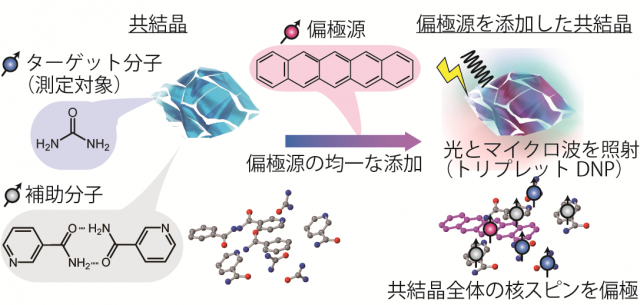Successful Development of a Cocrystallization Technique to Increase the Variety of Molecules whose Spin Orientations can be aligned at Room Temperature ~A Significant Step Toward Precise Cancer Diagnosis and Determination of Therapeutic Effects Using Ultra-Sensitive MRI Based on Quantum Technology~.
Jul 17, 2024
A team of researchers from Takuya Kurihara at Faculty of Chemistry, Institute of Science and Engineering, Kanazawa University, Tokushima University, QIQB (Center for Quantum Information and Quantum Biology), Osaka University, Osaka University’s Premium Research Institute for Human Metaverse Medicine (PRIMe), Center for Computational Sciences, University of Tsukuba have developed a cocrystallization(*1) technique to increase the variety of molecules to which triplet DNPs (*2) are applicable. Furthermore, they enabled triplet DNPs of multiple molecules including urea, an MRI molecular probe(*3), at room temperature.
The research team focused on DNPs using photo-excited triplet electron spins (triplet DNPs), which can align their spins at room temperature through quantum mechanical processes induced by light and microwave irradiation. Although triplet DNP has been studied for a long time, there are still issues to be solved in applying this technique, and the types of molecules to which it can be applied have been limited.
In this study, we developed a cocrystallization technique as a method to dramatically increase the types of molecules to which triplet DNP can be applied. We developed a cocrystal composed of an analyte, coformer, and a polarization source, which is the source of sensitivity enhancement, and realized triplet DNPs of multiple molecules including urea, an MRI molecular probe, at room temperature.
These findings are expected to lead to ultra-sensitive MRI that enables precise cancer diagnosis and treatment decisions, which have been difficult with conventional methods, by combining the cocrystallization technology proposed in this study with MRI in the future.
These results were published in the online edition of the Journal of the American Chemical Society on May 17, 2024 at 10:00 (Japan time).
 Figure: Schematic representation of cocrystals as matrices for spin polarization using triplet-DNP.
Figure: Schematic representation of cocrystals as matrices for spin polarization using triplet-DNP.
This research was supported by the Ministry of Education, Culture, Sports, Science and Technology’s Quantum Leap Flagship Program (Q-LEAP) (Grant No. JPMXS0120330644), the Japan Society for the Promotion of Science’s Grant-in-Aid for Scientific Research (Grant No. 21H01965), the JST Next Generation Researchers Challenging Research Program (Grant No. JPMJFS2130), the JSPS WPI “Human Metaverse Disease Research Center (PRIMe)”, and the Tokushima University Graduate School of Industrial Science and Technology’s Manufacturing Future Co-Creation Organization.
Glossary
*1: Cocrystal
Cocrystals are crystals in which multiple types of molecules are assembled through hydrogen bonds or π-π bonds. In this work, we focused on various types of cocrystals and showed that triplet DNPs can be formed.
*2: Triplet DNP
This is a type of DNP. The methods are that the detection sensitivity of NMR can be increased by transferring the electron spin bias of the photo-excited triplet of a molecule to the nuclear spin. Since the electron spin polarization is independent of temperature and magnetic field strength, DNP can be performed in mild environments (e.g., room temperature without agar and in low magnetic fields of 0.1 to 0.6 T, where the resonance frequency of the electron spins is in the microwave region).
*3: MRI molecular probes
This means a type of molecular sensor that changes its NMR or MRI signal in response to the in vivo environment or reaction.
Click here to see the press release【Japanese only】
Journal of the American Chemical Society
Researcher’s Information: Takuya Kurihara

